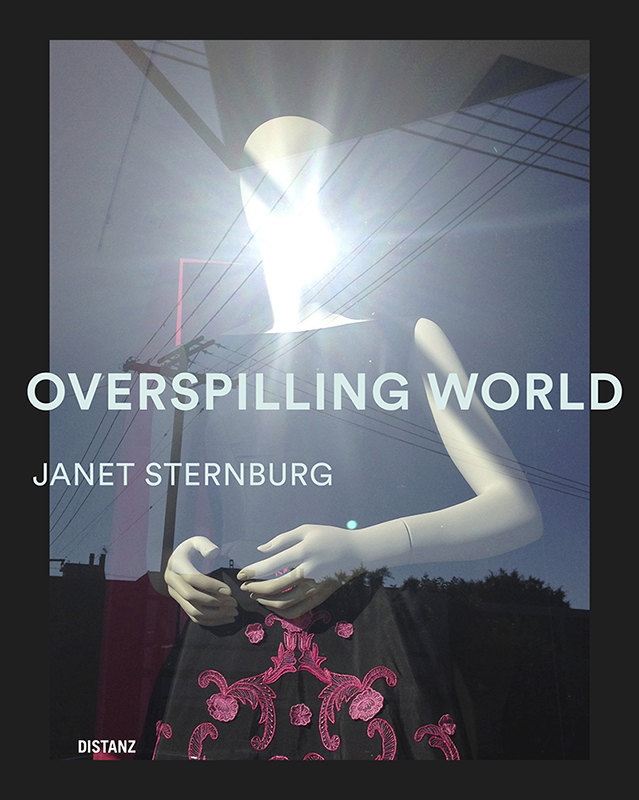
Overspilling World: The Photographs of Janet Sternburg
144 page monograph, Distanz Verlag, Berlin, 2016/17 with essays by Wim Wenders, Catherine Opie, Pepe Karmel, Alexandra von Stosch

________________________________
January 20, 2017 (Los Angeles/Berlin)—
DISTANZ VERLAG presents artist Janet Sternburg’s first monograph Janet Sternburg: Overspilling World. The publication showcases nearly two decades of work by the photographer and author. The book also includes texts by art historian Pepe Karmel; photographer Catherine Opie; curator Alexandra von Stosch; and filmmaker-photographer Wim Wenders. The new monograph will be celebrated with a series of book-launch presentations, featuring talks and book signings with Sternburg in Milan, Berlin, Paris, and Los Angeles.
As Wim Wenders notes in his foreword, “Photographers don’t have eyes in the back of their heads. Janet Sternburg does. This book makes you understand the act of seeing and the reflection that might lead to a photograph in a whole new way.” Working without any digital or optical manipulation, Sternburg employs disposable cameras and early iPhone cameras to take her photographs, utilizing their technical limitations – e.g., no depth of field -- to portray the conflations of time and space present in a single moment, to create an intermingling world. Sternburg’s works are images of consciousness—its fluidity and porosity—fused with everyday life.
Overspilling World traces the artist’s development as an established writer who first picked up a camera in 1998 while at her second home in San Miguel de Allende, Mexico. This later in life start has given her freedom from conventions. She often uses reflection not to mirror but rather to blur separations between inside and outside, solid and fluid, subject and object. As the 2018 Milan Photo Festival writes, “The stylistic secret of Janet Sternburg is the ability to grasp the incessant flow of vitality of everyday life. . . to restore the fullness of life.""
________________________________
Excerpt from Wim Wenders’ Foreword, Both Sides of the Moon
These are utterly contradictory photographs, that's for sure. They all seem to be more interested in seeing what photographers normally can't see, or overlook. Photographers don't have eyes in the back of their heads. Janet Sternburg does. Her book OVERSPILLING WORLD, makes you understand the act of seeing and the reflection that might lead to a photograph in a whole new way. It is about the nature of photography, intense and confusing but definitely essential. It makes you reflect upon photography, it reflects all our ideas about it and throws them back at us. It shows us a kaleidoscope of reflections, image upon image layer upon layer, light upon light, and world upon world. 
________________________________
Excerpt from Alexandra von Stoch’s essay Ambiguity in Motion
We have come a long way from the notion of “idea photography” that Alfred Stieglitz claimed more than a century ago for "pictorial" or artistic photography, transcending the documentary. . . . Clearly {Sternburg’s} images call for a new way of reading photographs. All the great theorists of photography from Walter Benjamin to Roland Barthes, Susan Sontag, and John Berger have stressed the problematic, ambiguous character of a photograph: It is the frozen image of a given reality, and at the same time, it represents a proof of its discontinuity. . . Sternburg’s unique layering or "over-spilling" approach to photography actually resolves this ambiguity. Paradoxically, by embracing ambiguity she overcomes the temporal gap. . . it is not a ‘problem’, but rather an artistic strategy.
________________________________
Excerpt from Catherine Opie’s Reflection
It is throughout the world that Janet Sternburg traveled and created this body of work, which gives pause to the metaphorical nature of reflection. . . . We are asked to look and decipher time and time again what lies before us. What are we looking at? We are asked to go beyond the depiction of space and into the abstraction of reality. . . The figure is prominent throughout this work, but it looks past the figure. What is surface? What is reflection? This is what holds me in thinking about the work. It is that question of what connects us to the real. Signs pop in behind and overlay the figure in shop windows, the sky is ever present, red is blood, it is internal and external, and it truly is an “over-spilling world.”
________________________________
Excerpt from Pepe Karmel’s Afterword Pictures from a Gnostic Universe
. . . If you look at maps, you will find the towns labeled Los Angeles, New York, or San Miguel de Allende, where the photographs were taken. But Sternburg’s camera has transfigured them, turning solid streets and buildings into shimmering films floating over scenes of tragic bric-a-brac. Eugène Atget may have been the first photographer to aim his camera into shop windows, capturing elegant mannequins framed by the facades of the Paris boulevards. Decades later, Lee Friedlander used shop windows to create a series of spectral self-portraits, recording his own shadow as it slithered between bright reflections and dark interiors. Painter Richard Estes used photographs to superimpose the apartment houses of Upper Broadway onto the windows of shops and diners. At moments, Sternburg’s pictures recall these antecedents, but only to revise them by adding more complex, suggestive imagery.
________________________________
Excerpt from Janet Sternburg’s essay THERE FOR THE SEEING
Many years ago, I saw a short film for children instructing them about what is inside and what is outside: this table is inside, this chair is outside. It made a huge impression on me because it made me so angry. How could the filmmakers limit a child’s imaginative grasp of the ever-changing fluidity of mind and experience? I’ve since read that it is the brain that delineates inside and outside, that we ourselves activate the boundary by means of neural structures. In my photographs, I want to deactivate that boundary . . . My choreographer friend Trisha Brown, upon seeing my very large prints, said, “I want to walk into them.” What would happen, I ask myself, if I could walk into one of my photographs? I imagine treading through layers, not strata but conflations of time and space through which I would simultaneously experience surface and depth, present and past – in other words, a multidimensional world that exists within a single moment.
________________________________
Read Jack Miles's review of Overspilling World in the Los Angeles Review of Books
________________________________
Upon the publication of Overspilling World, there were a number of national (Hauser and Wirth, New York and Los Angeles) and international (Milan, Berlin, and Paris) launch events.

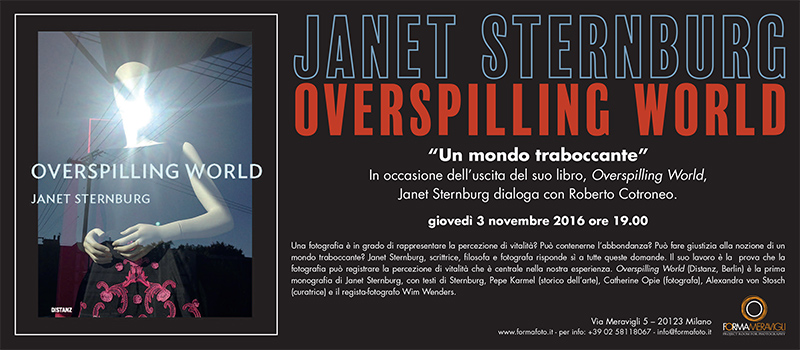

Contrasto Galleria, Milan: Janet Sternburg, Elisabetta Zegna
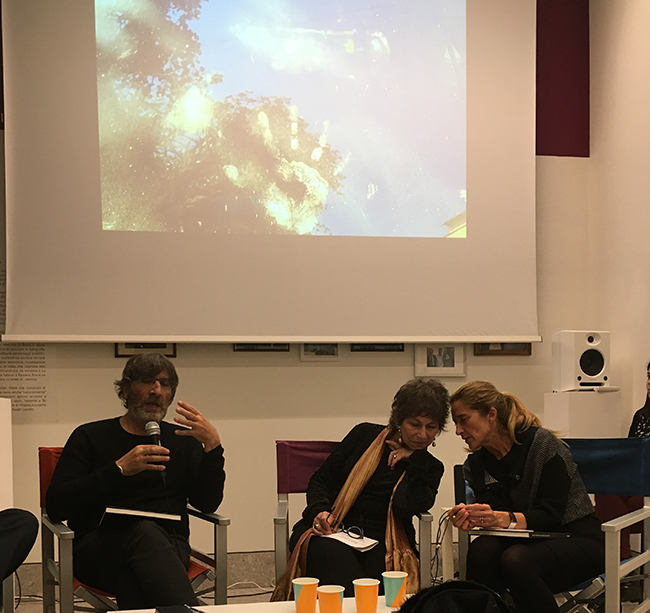
Roberto Cotroneo; Janet Sternburg; Alessia Palladino.
 copy.jpg)
Steven Lavine, President Emeritus, CalArts; Alexandra von Stosch, curator/writer; Uta Grosenick, former publisher Distanz Verlag;
Janet Sternburg, artist; Kimberly Marteau Emerson, human rights advocate, John Emerson, former U.S. Ambassador to Germany.
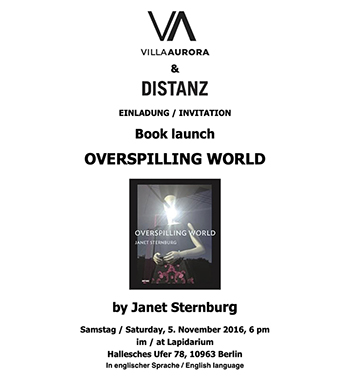
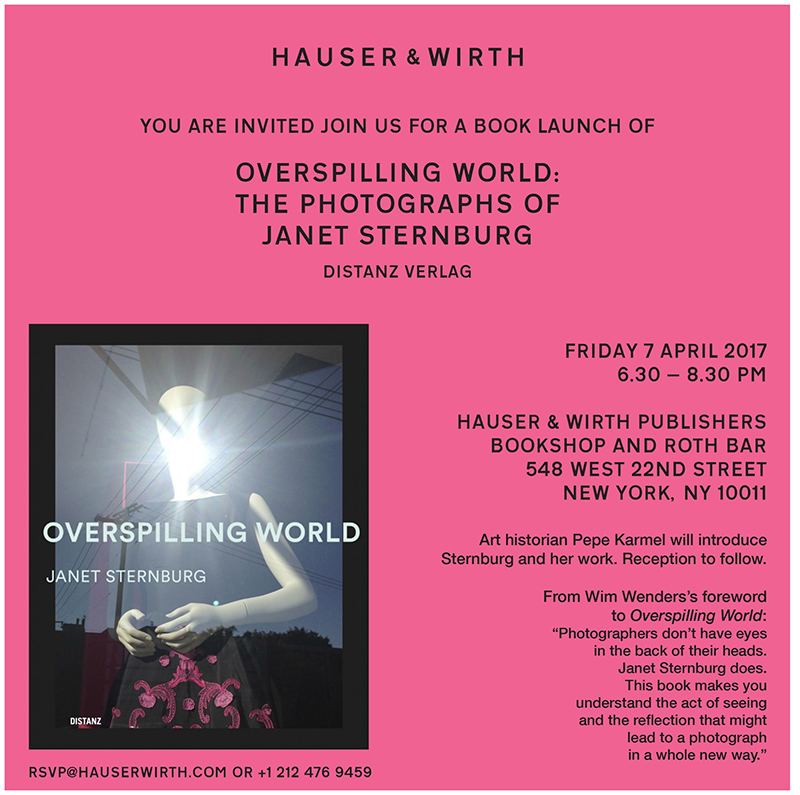
...